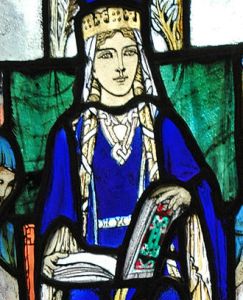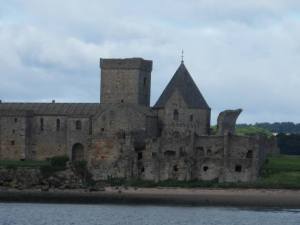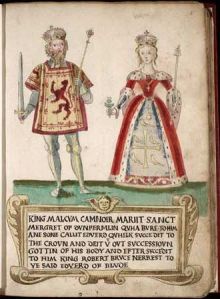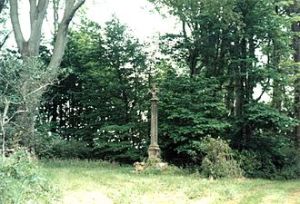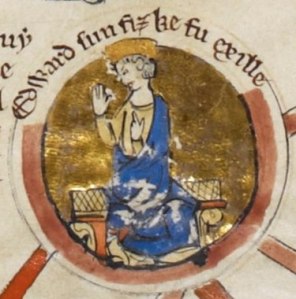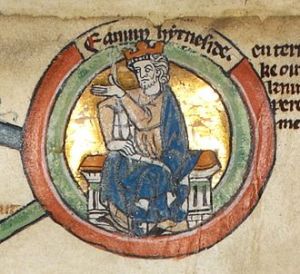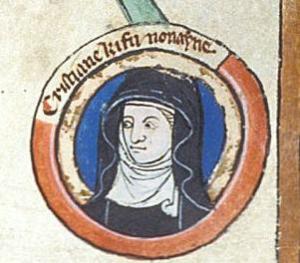
Today it is a pleasure to welcome Annie Whitehead to History … the Interesting Bits as a stop on her Women of Power in Anglo-Saxon England Blog Tour.
Women of Power in Anglo-Saxon England examines the lives of individual women in a way that has often been done for the Anglo-Saxon men but not for their wives, sisters, mothers and daughters. It tells their stories: those who ruled and schemed, the peace-weavers and the warrior women, the saints and the sinners. It explores, and restores, their reputations.
Over to you Annie….
All the Ælfgifus
I was recently interviewed on BBC Radio Northampton where we chatted about a lady known as Ælfgifu of Northampton. During the pre-recording chat, it became clear that there was some confusion over the name. I told the presenter that I wasn’t the least surprised, as there are no fewer than eight ladies with that name featured in my new book. I thought I’d take this opportunity to introduce them. (The name, incidentally, translates as Elf-gift, which I think is rather beautiful.)
Ælfgifu, daughter of Edward the Elder

We don’t know a great deal about her but I do feel rather sorry for her. She and her sister, Eadgyth, were, apparently, both sent to Germany so that the future emperor, Otto, could choose one of them as his bride. He married Eadgyth – it was, apparently, ‘love at first sight’ – and Ælfgifu married another prince. What Ælfgifu felt about being rejected by Otto, we can only surmise. Of course, Otto might not have been every young girl’s dream, in which case Ælfgifu might have considered that she’d had a lucky escape. It must have rankled though, being declared less attractive than her sister.
Ælfgifu of Shaftesbury
King Edmund was the son of Edward the Elder and a half-brother of the Ælfgifu mentioned above. He became king at around the age of eighteen and his first wife, Ælfgifu, bore him two sons, both future kings. Her identity is debateable and her background unknown. She wasn’t married for long. Her son Eadwig (I’ll come back to him) was probably born around 940, and his younger brother Edgar around 943. King Edmund himself died in 946 – the victim of a brawl, or perhaps a political assassination – having married again, so his first marriage must have ended not long after Edgar’s birth. Ælfgifu is known as Ælfgifu of Shaftesbury, and it would be easy to assume that she retired to Shaftesbury Abbey in the manner of a number of previous queens, but the short-lived nature of her marriage and the young age of her children suggest another scenario. It is plausible that she died in childbirth, either in labour with Edgar or with a subsequent pregnancy in which both mother and child died. If she did indeed die in childbirth then she cannot have been a nun at Shaftesbury, but merely a benefactor.
Ælfgifu the Harlot

Ælfgifu the Harlot
In 955 Edmund’s brother, who’d succeeded him, died and was in turn succeeded by Edmund’s son, Eadwig (see, I told you I’d come back to him). Life at court got rather interesting when Eadwig, still only a teenager, married a young woman named Ælfgifu. Many of you will know the story of how he was found in bed on his coronation day with his wife, and her mother. Depending on which version one reads, the mother was banished and/or hamstrung in punishment, or she threatened the abbot who found them, and who was himself subsequently banished, that she would have his eyes put out if he ever returned. The young couple’s marriage was annulled two years later, on the grounds that they were too closely related. However, Ælfgifu is presumed to be the same woman who left a will, in which she’s identified as being descended from the brother of Alfred the Great. This being so, she was descended from the branch of the royal family that had risen up in rebellion. Ælfgifu’s marrying the king might have been seen as an attempt to strengthen those claims. It’s not a theory which I whole-heartedly embrace but it does seem that there was a lot of political manoeuvring at court and I suspect Ælfgifu was an innocent caught up in the turmoil. She was certainly welcomed back to court by Eadwig’s brother when he became king.
Ælfgifu of York – Possibly

That brother of Eadwig’s had a son, known to history as Æthelred the Unready. His first wife’s identity is a bit of a mystery. The chronicler John of Worcester said that she was called Ælfgifu, and that she was the daughter of an ealdorman called Æthelberht. But there is no evidence of this woman’s father; no ealdorman named Æthelberht is recorded elsewhere. Roger of Wendover said that she was a ‘woman of low birth’, while Ailred of Rievaulx, writing in the mid-twelfth century, said that she was the daughter of a man named Thored, but he didn’t name her. It is possible that Æthelred was married first to a woman named Ælfgifu and then to the daughter of Thored, but it is generally accepted that this was one woman and, combining the two versions, that she was Ælfgifu, daughter of Thored.
We don’t hear much from her as she didn’t witness any charters and is otherwise unnamed in the sources. What she did do, though, is have at least nine children, (one of whom was also called Ælfgifu, whose husband was murdered by her sister’s husband, which must have made for awkward family Christmases)! She must have lived until the eleventh century, for her youngest son, Edgar, did not appear on charter witness lists until 1001. We do not know exactly how old the royal children would typically have been when they first appeared on the witness lists, but we do know that they were sometimes still babes in arms. It is not known what happened to Ælfgifu and it is possible that she died at around the same time, for King Æthelred got married again in 1002…
…To a woman named Emma, but who was given the English name of Ælfgifu. As if this wasn’t confusing enough! And after Æthelred the Unready died, Emma married again. Her husband was King Cnut, who already had a wife/concubine:
Ælfgifu of Northampton

This Ælfgifu came from a powerful Mercian family. Her father was ealdorman of Northumbria, her uncle founded Burton Abbey and her grandmother founded Wolverhampton. Ælfgifu’s father was murdered and her brothers were blinded and generally Æthelred the Unready mistrusted the family, as well he might. For at some point, possibly around 1013, Ælfgifu married Cnut, the son of the invader, Swein Forkbeard. She had two sons by Cnut, and they were given Danish names – Swein and Harold – as if recognised as potential heirs, but when Cnut became king, he married Emma and also had a son with her, who was named Harthacnut.
Emma, with her credentials as an English queen, was no doubt important to Cnut, but so too was Ælfgifu of Northampton, and Cnut had a task for her to perform. Cnut had an empire to rule, and Harthacnut was sent to Denmark while in 1030, Ælfgifu and her son Swein were sent to Norway, there to rule for Cnut. The regency in Norway may have been hugely symbolic, and it is telling that the period was remembered in Scandinavian history as ‘Ælfgifu’s time’, but for various reasons it wasn’t hugely successful. Swein died in 1035, but so too did Cnut.
Now a (rather unseemly at times) battle began as Emma and Ælfgifu fought for their sons to succeed. You can read all about these fraught years in my new book but the upshot was that Ælfgifu was successful in the short term and Harold ‘Harefoot’ became king. Sadly though he died in 1040. We don’t know what happened to Ælfgifu after this, but there is a French twelfth-century story which speaks of a woman named Alveva and it’s possible that she lived out her years as an exile in southern France.
By 1066, another Harold was on the throne. He had a wife/concubine who’s known to history as Edith Swanneck, and one of her children was a daughter named Ælfgifu.
Ælfgifu the Unlucky
But the last Ælfgifu I want to talk about is one I’ve nicknamed ‘unlucky’. You’ll recall that Ælfgifu of Northampton’s brothers were blinded. They weren’t the only ones and in 993 a man named Ælfgar suffered the same fate. His wife was another woman named Ælfgifu. When Ælfgifu of Northampton’s father was killed and her brothers blinded, another man was named as being deprived of all his property. With a little bit of detective work I was able to say with some degree of certainty that this man was the second husband of our last Ælfgifu, which means that her first husband was blinded and the second was deprived of all his property. Given that it’s clear the name Ælfgifu seems to have been given only to noblewomen, I think this one must have expected a slightly more comfortable and uneventful life!
Follow the Blog Tour!
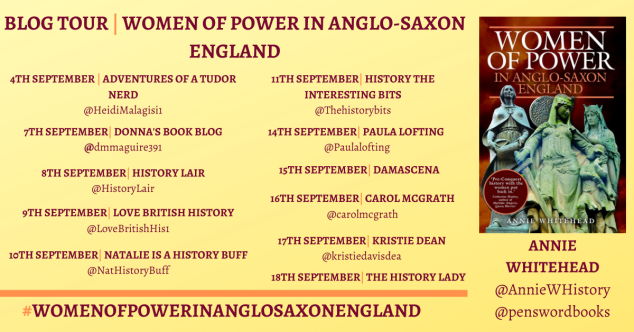
Annie’s book, Women of Power in Anglo-Saxon England, was published by Pen & Sword Books in June 2020. It can be purchased from Pen & Sword and online.
About the Author:

Annie is an author and historian and an elected member of the Royal Historical Society and has won awards and prizes for her fiction and nonfiction.
Published works include Mercia: The Rise and Fall of a Kingdom (Amberley Books) and novels and stories set in Anglo-Saxon England, including To Be A Queen, the story of Æthelflæd, Lady of the Mercians, longlisted for HNS Book of the Year 2016. She was the inaugural winner of the Dorothy Dunnett/HWA Short Story Competition in 2017. You can connect with Annie through her Website, on Facebook, Twitter and on her Blog and Amazon Author Page.
All images are in the public domain.
*
My Books
Ladies of Magna Carta: Women of Influence in Thirteenth Century England looks into the relationships of the various noble families of the 13th century, and how they were affected by the Barons’ Wars, Magna Carta and its aftermath; the bonds that were formed and those that were broken. It is now available from Pen & Sword, Amazon and from Book Depository worldwide.

Also by Sharon Bennett Connolly:
Silk and the Sword: The Women of the Norman Conquest traces the fortunes of the women who had a significant role to play in the momentous events of 1066. Available now from Amazon, Amberley Publishing, Book Depository.
Heroines of the Medieval World tells the stories of some of the most remarkable women from Medieval history, from Eleanor of Aquitaine to Julian of Norwich. Available now from Amberley Publishing and Amazon and Book Depository.
*
You can be the first to read new articles by clicking the ‘Follow’ button, liking our Facebook page or joining me on Twitter and Instagram.
©2020 Sharon Bennett Connolly










